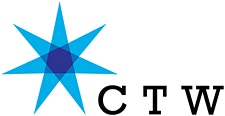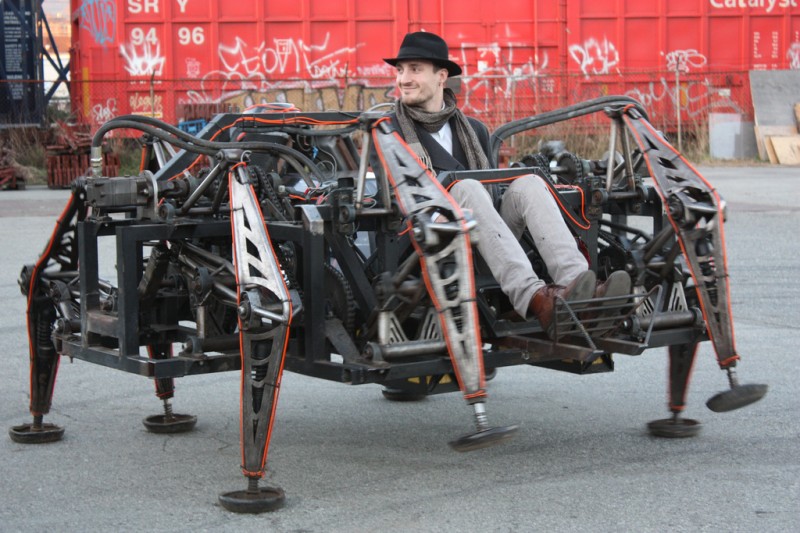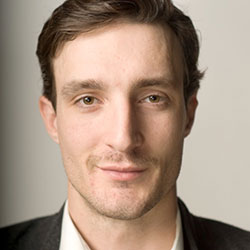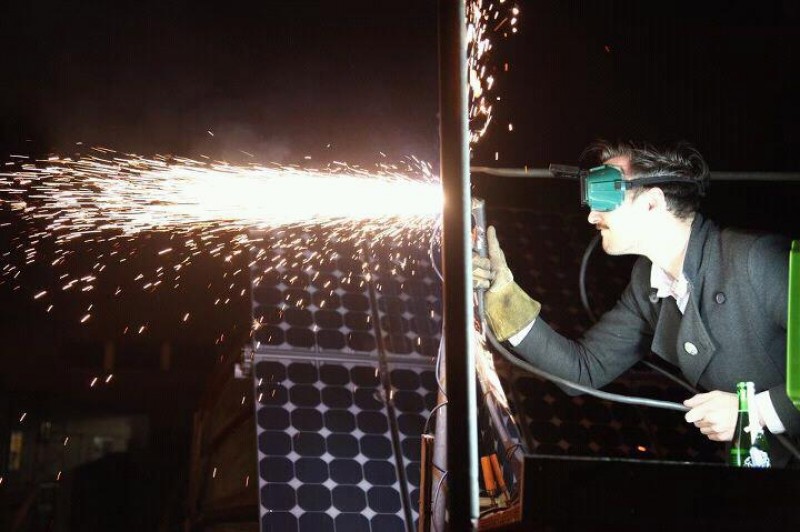A Conversation about MIT, folding skateboards, a robotic spider and why Leigh Christie chose to live in NYC. By Gary Shapiro
Gary Shapiro is a writer whose work has appeared in the Wall Street Journal, the Forward, and in the Features section of CreativeTechWeek.nyc.
Leigh Christie is a creative technologist and arthacker who manifests otherworldly inventions, products and artworks. He is lead innovation engineer at Isobar, a full-service global agency, and manager for Isobar’s NowLab Americas. Leigh led a team of engineering students to build Western Canada’s first solar powered vehicle at the University of British Columbia. He then went on to design battery packs and EV components for several automotive startup companies. Leigh is also the founder of MistyWest Energy and Transport, a Vancouver-based engineering and product design company; co-creator of the Mondo Spider, a pure-electric 1,500 lb walking vehicle; and co-founder of the eatART Laboratory in Vancouver, BC. He has a masters in Art, Culture and Technology from the MIT Media Lab and an undergraduate degree in Engineering Physics from UBC.
GS: What makes New York a great place for creative technology?
LC: New York is the best place for creative tech. If you compare it to Boston, Los Angeles or San Francisco, you have the art world here and a tremendous amount of capital, where businesspeople and philanthropists buy and fund great work. You also have the presence of technology from various universities, such as Parsons, School of Visual Arts, etc. All of these people cluster around New York. Even if they’re based in Boston, they still come here to show their work. For example, all the artists whom I know from Vancouver, where I am from, also come here to show.
In fact, if you look at the partnership list from Creative Technology Week, you will see just how many organizations in the city are helping creative tech or digital artists to further their careers. You also have Eyebeam, Leaders in Software and Art (LISA), and many others making artists thrive.
If you are talking about large-scale sculpture, I would say that San Francisco is best. In New York, it’s tough to find space with a big bay door and a five-ton crane, but in San Francisco — especially in Oakland — there’s a ton of that. But if you want to do more scalable work on the digital end of the spectrum, New York beats them all.
I think internationally, Berlin is one of the best. The costs are lower than New York, and the community there is amazing. I have never made art in Berlin, but I gave a talk there at the event series, retune, about the Mondo Spider.
GS: Let’s start then with the Mondo Spider, which is surely your most well known project to date: a 15,00-pound metal sculpture that walks electrically with someone at the controls.
LC: Yes, that is definitely my most well known piece, and the other pieces get a little jealous.
GS: What was the inspiration for that?
LC: The Mondo Spider, which was first built in 2006, is currently housed in Vancouver at a place called eatART Foundation. It is still a working sculpture that we continue to improve and maintain. The inspiration for the Mondo Spider was a contest called “The Vancouver Junkyard Wars.” Jonathan Tippett, Charlie Brinson, Ryan Johnson are among those who have also worked on it. We formed a team to compete in an engineering competition, in which the best engineers in Vancouver — of all ages — participated. That year we built a walking machine out of bicycle parts, 2 x 4 pieces of wood – basically, junk. When we finished building, it took about 10 steps and then broke. We were very disheartened.
GS: What happened next?
LC: All of us felt so strongly that we had to try again.
GS: What was the reaction after rebuilding it?
LC: The initial reaction was awe and wonderment. My favorite reaction is when people are in disbelief. It looked impossible to make. Keep in mind that back then there were very few commercial walking robotic operations that were well documented on YouTube. Boston Dynamics, for example, had not yet released BigDog at that point, which is probably the most well known walking machine these days. It’s a military robot. Boston Dynamics was bought by Google, which is likely taking the company in a new direction.
GS: Where do you work in Manhattan?
LC: I’m in a very fortunate position here in New York where my crazy ideas are very supported and encouraged by my current employer, Isobar, a global digital agency. My background is as an engineer, artist, and entrepreneur. When I first came to New York, some some friends from MIT were very generous and recommended that I meet the people at Isobar. I quickly realized that this was a company full of brilliant people, and my skill set with consumer electronics, startups and inventing things was a good match. They have been very supportive. Isobar has a system of distributed laboratories, called the NowLab, which exist at 17 of the company’s total 70 offices.
GS: What do you like most about your job?
LC: My favorite aspect is working with brilliant people, one of whom is Dave Meeker, an inventor, creative coder, and expert in all things digital. Isobar is a sponsor of MIT Media Lab. That’s how Dave found me.
At Isobar, I am helping replicate the success of the NowLab across South and North America. The NowLab, in its present form, is a maker or hacker space, where anyone in the company can come in there and make or create. Those in the NowLab at Isobar have initiated many projects.
GS: What projects are you working on presently?
LC: Working at Isobar I get the opportunity to bring many creations and ideas to life. One of my projects is eyeSelfie, which is a way of taking a selfie of your iris. Some would make a connection with a film called I Origins, where there was a character that took pictures of people’s eyes and irises. Ours is similar to that, but with higher resolution and projected onto surfaces. I’m not going to say much more about that, because I don’t want to reveal some surprises.
GS: What inspired you to make a folding skateboard?
LC: I was recently awarded a patent for an invention I came up with in 2013 called the Ori Board — which is short for origami skateboard.
Imagine you have this briefcase and you throw it down on the ground and suddenly you have your own personal electric vehicle. I call it “concealable transportation,” though, because when you walk around with it, it just looks like a briefcase. The original prototype was stolen here in New York from Broad Street subway station, and it was a blessing in disguise. On the one hand, it was the only folding skateboard in the world, and I used it every day. But it made me realize that people wanted this so badly that they were willing to steal it. So I posted online the image of a little “Lost Folding Skateboard” poster and all my friends said, “You have to make this thing.” A lot of people want one now. I built mine from scratch, using burlap and epoxy. But the next version is going to be mass-produced; it’s also open source so anybody can build his or her own. Presumably, though, people will want to buy one from us. There will be two versions, one electric and the other one not.
GS: Did you do this at your current employer, Isobar?
LC: I invented the Ori Board before I was at Isobar. I built the first prototype as a project for a course called “How to Make Almost Anything” at MIT. But now the project is being commercialized by a Vancouver company I co-founded called MistyWest. My business partner, Josh Usher, and I started MistyWest in 2003, as a skimboard and skateboard company, while we were undergraduates in Engineering Physics at University of British Columbia. In 2008, we pivoted and started working on all sorts of consumer electronics, electric vehicle projects, helping our clients with product design as well as market positioning.
GS: I see you were the lead engineer on a product called the Copenhagen Wheel, at MIT’s SENSEable City Laboratory. Can you say more about the project?
LC: The name of the company is Superpedestrian. Assaf Biderman, who is part of SENSEable City Laboratory, co-invented it. The Copenhagen Wheel is the name of their product. It’s a really cool wheel that can turn any ordinary bicycle into an electric bicycle.
GS: Let’s go back earlier in your career. I see that you completed a master’s degree at MIT in Art, Culture and Technology.
LC: The program taught me to think like an artist and remove my engineering hat.
GS: Did you have a teacher there who influenced you?
LC: Two were Antoni Muntadas, whose multimedia work often has a strong political or social justice aspect, and Joan Jonas, a pioneer of performance art. They would offer blunt criticism. You know you are doing something right, when you draw strong opinions from them. I also learned that you cannot just set rigid goals and give up when something doesn’t work. Every time you fail, that lesson learned is data, and those failures are what drive innovation.
GS: At South by Southwest, you gave a talk called “Art vs. Purpose: Innovation in Marketing.”
LC: The title was intended to be provocative.
GS: What did you mean by it?
LC: A lot of artists believe that if you have a purpose or a goal when you’re making an art project, then you’re doing it wrong. Traditional artists especially think this. That said, if you look at this new generation of multimedia artists and creative coders, many learned how to code at 12 years old. Compare this to years back, where Robert Rauschenberg and many famous artists and engineers were involved Experiments in Art Technology (E.A.T.). Likewise, Ars Electronica, and others were a nexus for new media work before the mainstream art world really recognized the value of this kind of art. It has gained traction, as Biennales, museums, and galleries have incorporated more of these interactive installations. For some, there is a clash of processes, where the goal oriented artists may find themselves behaving more like scientist and engineers.
GS: Again at South by Southwest, you said in your talk that creative people can pursue their art in the context of brand building and reaching consumers in completely unexpected ways. Are you saying that artists do not have to choose between art and commerce?
LC: Yes, in some ways. But I am sort of running the wrong way on an escalator here. If your goal is to be an artist and have the most impact, then I don’t think the best way is to combine art with commerce and marketing.
Most artists don’t care about marketing. Their perception is that marketing is making people want things they would otherwise not want. The perception is if that you’re manipulating them by selling them something that they do not want. But marketing can be a process of learning about humankind and what drives us forward in our desires. It can be an experiment.
GS: What is an average weekend for you?
LC: My company MistyWest, the non-profit eatART, and other projects get a good deal of my evening and weekend time. I am also on a board of advisors of Generate App, which was founded by Malcolm Levy, an artist based in Vancouver and at NEW INC, which is an art and technology incubator in New York that is attached to the New Museum. Generate App is a bit like a real-time Adobe Photoshop, where you put live filters on photos. I don’t mean like Instagram, but one in which you have more full artistic license.
GS: Who are ones to watch in creative tech?
LC: There are many, but I’ll name a handful. I love the work of Jamie Zigelbaum, who is a member of Dark Matter Manufacturing, a cooperative space based at the Metropolitan Exchange building in Brooklyn.
Andy Cavatorta is also based out of Dark Matter. Keep your eyes peeled for more work by Malcolm Levy. I’m a big fan right now of Alex Staudt (“FuzzyWobble”), who is a “digital alchemist”. He’s the creator of the GIF dance party. I’m also a massive fan of Jonathan Tippett, the most dedicated, ambitious, large-scale artist I know. You should watch for Anne Macmillan, a talented Canadian artist. Another is Omer Arbel, who has had a big influence on me. He is an artist, industrial designer, and architect, based in Vancouver and Berlin. He’s the co-founder of Bocci, which makes high-end lighting. Also, I’ve never met her, but Mary Mattingly has been a big influence on me as well.
GS: What do you hope to do artistically in New York that you haven’t yet done?
LC: One thing I haven’t done here is “A New Industrial Utopia,” a performance that I did in Vancouver and in Kolkata, India, where I plasma cut art out of thin metal in real time in front of an audience. It’s entertainment: I blast music, and let audience sort of peek behind the curtain to see how this art is done. I do it just for fun, to be honest. I love doing and sharing it. I’m connecting to people. You could call it performance sculpture, if you want.
GS: I saw a geodesic dome on your web page. Are you influenced by the work of polymath Buckminster Fuller?
LC: Yes, I have his book in my backpack, Operating Manual for Spaceship Earth.
I have built domes at the annual gathering, Burning Man. My girlfriend likes to help me build them into temporary homes, but she hates that it takes us about a day or two to build these things. It’s just so much easier to stay in a tent. But I have since invented, two years ago, a geodesic dome with hubs made of flat sheet metal, in which wood pops into the joints with the help of magnets. You can put this dome up in less than 20 minutes, whereas normally it takes you hours to make a metal dome.
GS: What else beside Buckminster Fuller’s book is in your backpack?
LC: A lot of battery packs. I keep five or six. I travel a lot to give talks and show work. I have very small battery packs so that I never run out of power. My favorite catch phrase is “Never, ever run out of batteries.”
GS: What do you think are some challenges that Creative Technologists will grapple with in the coming years?
LC: One of the biggest challenges now is perception: Creative Technologists are seen as neither fish nor fowl. It’s a hybrid term or hyphenated term, such that creative technologists can slip through the cracks. When they’re applying for funding, it can often be difficult for them to get an engineering grant, because what they are doing is not just strictly engineering. It can likewise be difficult for them to get an arts grant, because what they’re doing is not necessarily art by some people’s definition.
GS: Are you excited about Creative Tech Week?
I’m beyond excited. New York has needed something like this for so long. There have been plenty of smaller festivals that aren’t very specific to creative technology. A lot of them are too heavy on the painting side, or too heavy on the commercial technology side. This one is right in the sweet spot. This is the one everyone has been waiting for, and everyone’s talking about it.



